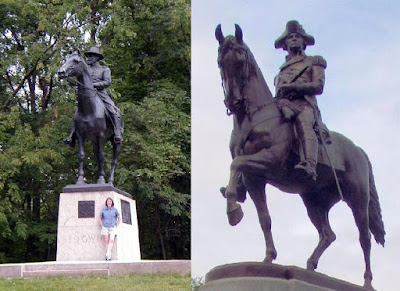 In statues, does the number of feet the horse has off the ground indicate the fate of the rider?
In statues, does the number of feet the horse has off the ground indicate the fate of the rider? The Straight Dope
06-Oct-1989
Dear Cecil:
What's the meaning of the number of feet the horse has off the ground in statues of war heroes? I recall hearing one foot off meant the person was injured and recovered while two feet meant he was fatally wounded. --Laury Hutt, Baltimore

Cecil replies:
Your columnist confesses he went into this figuring it was a crock. Your columnist goes into pretty much everything figuring it's a crock, for the obvious reason that when you consider most popular beliefs, the percentages are on your side. However, it's not like I wasn't willing to be convinced.
First we reviewed the literature. This consisted of looking at tourist guidebooks, which, as far as I can tell, are the main perpetuators of this yarn. Here's a typical version from one such guidebook, Hands On Chicago (1987), by Mark Frazel and Kenan Heise: "At Sheridan Road and Belmont Avenue, the statue of [General Philip H.] Sheridan beckons troops to battle. The horse General Sheridan rides is named Winchester. . . . Winchester's raised leg symbolizes his rider was wounded in battle (the legs of [General Ulysses S.] Grant's horse [as seen in another Chicago statue] are on the ground, meaning he was not wounded)." The book makes no mention of what two legs in the air means, but many people seem to think it indicates the rider died in battle.
Next I scoured texts on sculpture for any indication that sculptors actually used such a code. In vain. Not that I was exactly shocked, but one must be thorough. A historian for the U.S. Army Center of Military History also dismissed the story as a myth.
We then got down to the guts of the investigation. I got photos of 18 equestrian statues featuring historical figures (Napoleon, George Washington, etc.) in cities ranging from Chicago to Leningrad (well, that's what it was when I looked this up--now it's St. Petersburg). I then checked to see whether the individuals depicted had been wounded or killed.
This involved some guesswork. Does getting grazed by a bullet count as a wound? If the guy was assassinated, does that mean he was killed in action? Does it count the same if the horse has both front feet off the ground versus having one front foot and one back foot? I wrestled with these questions late into the night. Giving the code the benefit of the doubt, I determined as follows:
Code corresponds with subject's fate: 8 Doesn't correspond: 8 Not enough information to tell: 2
Significantly, in the two equestrian statues I turned up by Augustus Saint-Gaudens, one of the most famous sculptors of his day and someone who surely would have respected a code had there been one, I found that one piece did correspond with the code and one didn't. Granted, in this world of doubt and pain, one can be certain of nothing. But I say the code is BS.
THE TEEMING MILLIONS SAY NEIGH
Dear Cecil:
Recently you scoffed at the idea that in equestrian statues of war heroes, the number of feet the horse has raised indicates whether the rider was killed or wounded in battle. You are WRONG, WRONG, WRONG! There is at least one place in this great nation of ours where the horse code holds true, namely that most hallowed of Civil War battle sites, Gettysburg, Pennsylvania.
At Gettysburg, a statue that has all four of the horse's hooves on the ground means that the rider survived the battle without a scratch. One foot raised means the person was wounded but survived, and both forelegs raised indicates that the man was killed at Gettysburg. Obviously you are an imposter--the real Cecil (a true American) would of course have known this. I advise you to turn yourself in at once. --Theodore S. Shouse, Washington, D.C.
Cecil replies:
Just goes to show you, Theodore, there's good in all of us, even a zit like yourself. You've undoubtedly pinpointed the origin of the horse-statue myth. Others have told me they also heard it first at Gettysburg.
Turning to Gettysburg: The Complete Pictorial of Battlefield Monuments by D. Scott Hartwig and Ann Marie Hartwig (1988), we find photos of six freestanding horse statues (478 monuments and memorials are pictured all told). Sure enough, all six conform to the code you describe, except that the horse of General John F. Reynolds, who was killed at Gettysburg, has one foreleg and one hind leg raised, not both forelegs.
Does this mean there really is a code? Nah, it's just coincidence. You'd hardly invent a code to cover a lousy six statues--a code, moreover, that seems calculated to rile the family and friends of many of the depicted heroes. The horse in the statue of General John Sedgwick, for example, has all four feet on the ground. Sedgwick was killed in action, but at Spotsylvania, not Gettysburg. We're supposed to believe Sedgwick was denied his sculptural Purple Heart because he died in the wrong battle? Tell me another one. Further inquiries have turned up nothing to corroborate the existence of a code. Expunge it from your mind.
--CECIL ADAMS

No comments:
Post a Comment